HYUNDAI TUCSON HYBRID 2022 Owner's Manual
Manufacturer: HYUNDAI, Model Year: 2022, Model line: TUCSON HYBRID, Model: HYUNDAI TUCSON HYBRID 2022Pages: 630, PDF Size: 77.98 MB
Page 21 of 630
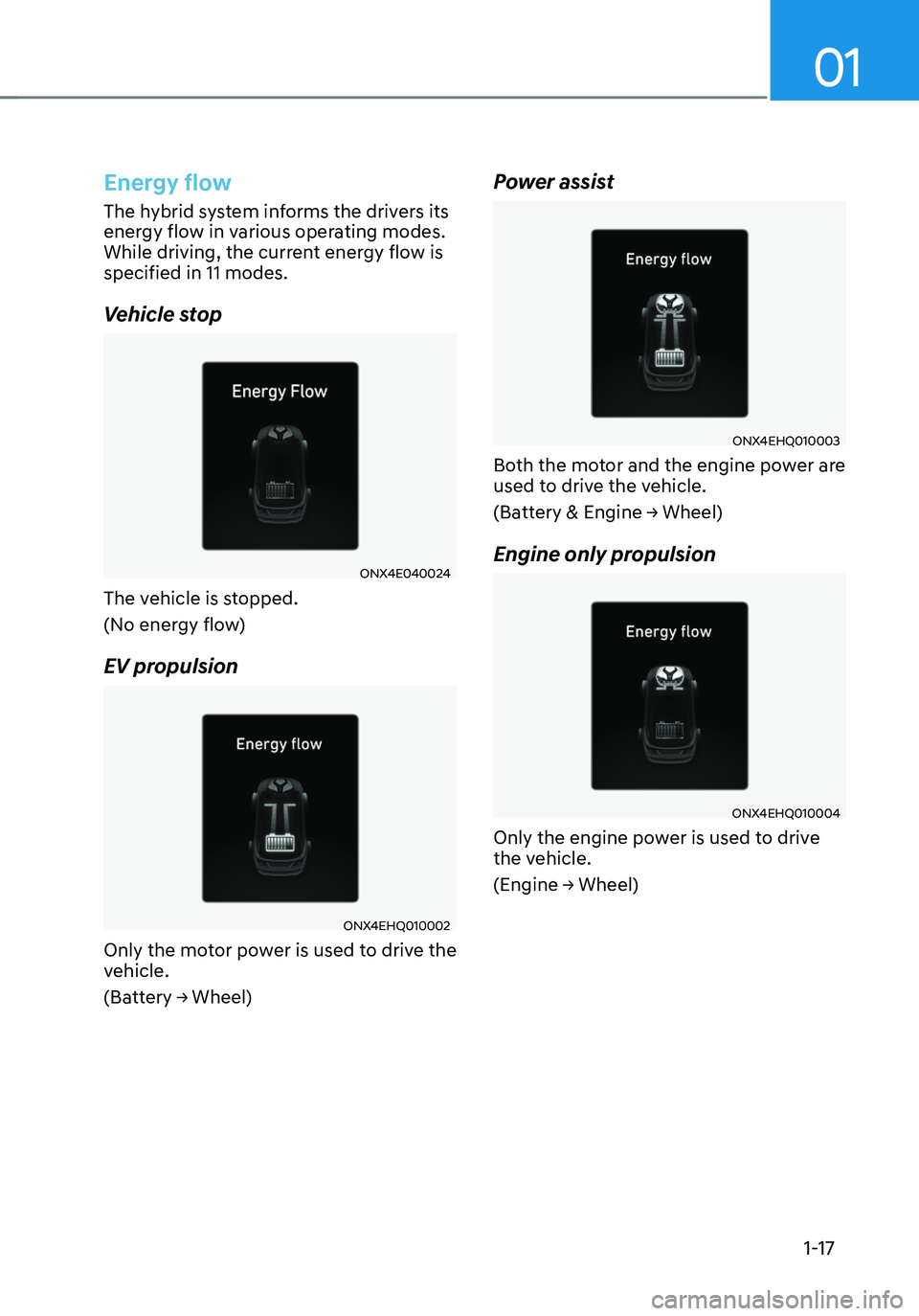
01
1-17
Energy flow
The hybrid system informs the drivers its
energy flow in various operating modes.
While driving, the current energy flow is
specified in 11 modes.
Vehicle stop
ONX4E040024
The vehicle is stopped.
(No energy flow)
EV propulsion
ONX4EHQ010002
Only the motor power is used to drive the
vehicle.
(Battery → Wheel)
Power assist
ONX4EHQ010003
Both the motor and the engine power are
used to drive the vehicle.
(Battery & Engine → Wheel)
Engine only propulsion
ONX4EHQ010004
Only the engine power is used to drive
the vehicle.
(Engine → Wheel)
Page 22 of 630
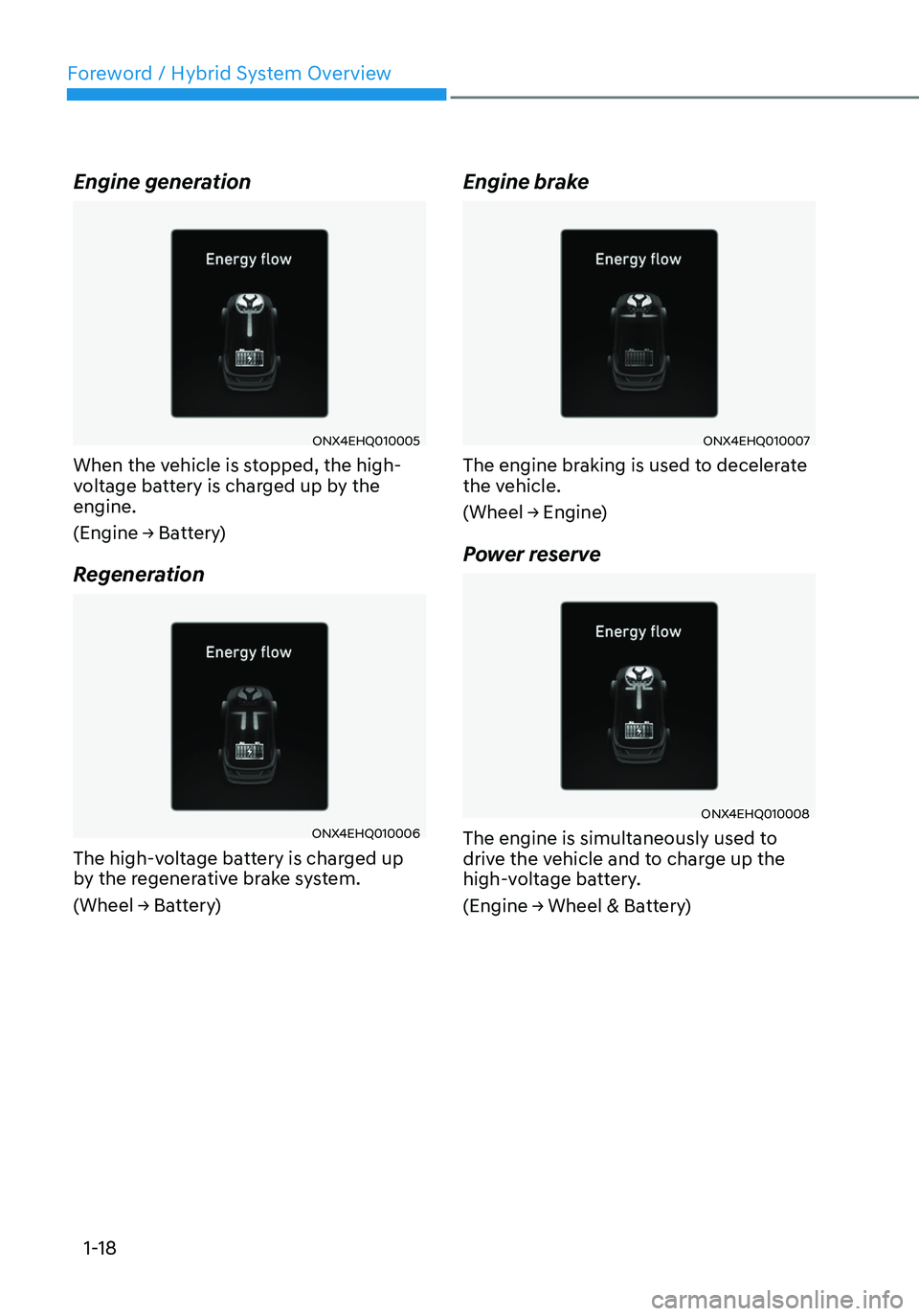
Foreword / Hybrid System Overview
1-18
Engine generation
ONX4EHQ010005
When the vehicle is stopped, the high-
voltage battery is charged up by the
engine.
(Engine → Battery)
Regeneration
ONX4EHQ010006
The high-voltage battery is charged up
by the regenerative brake system.
(Wheel → Battery)
Engine brake
ONX4EHQ010007
The engine braking is used to decelerate
the vehicle.
(Wheel → Engine)
Power reserve
ONX4EHQ010008
The engine is simultaneously used to
drive the vehicle and to charge up the
high-voltage battery.
(Engine → Wheel & Battery)
Page 23 of 630
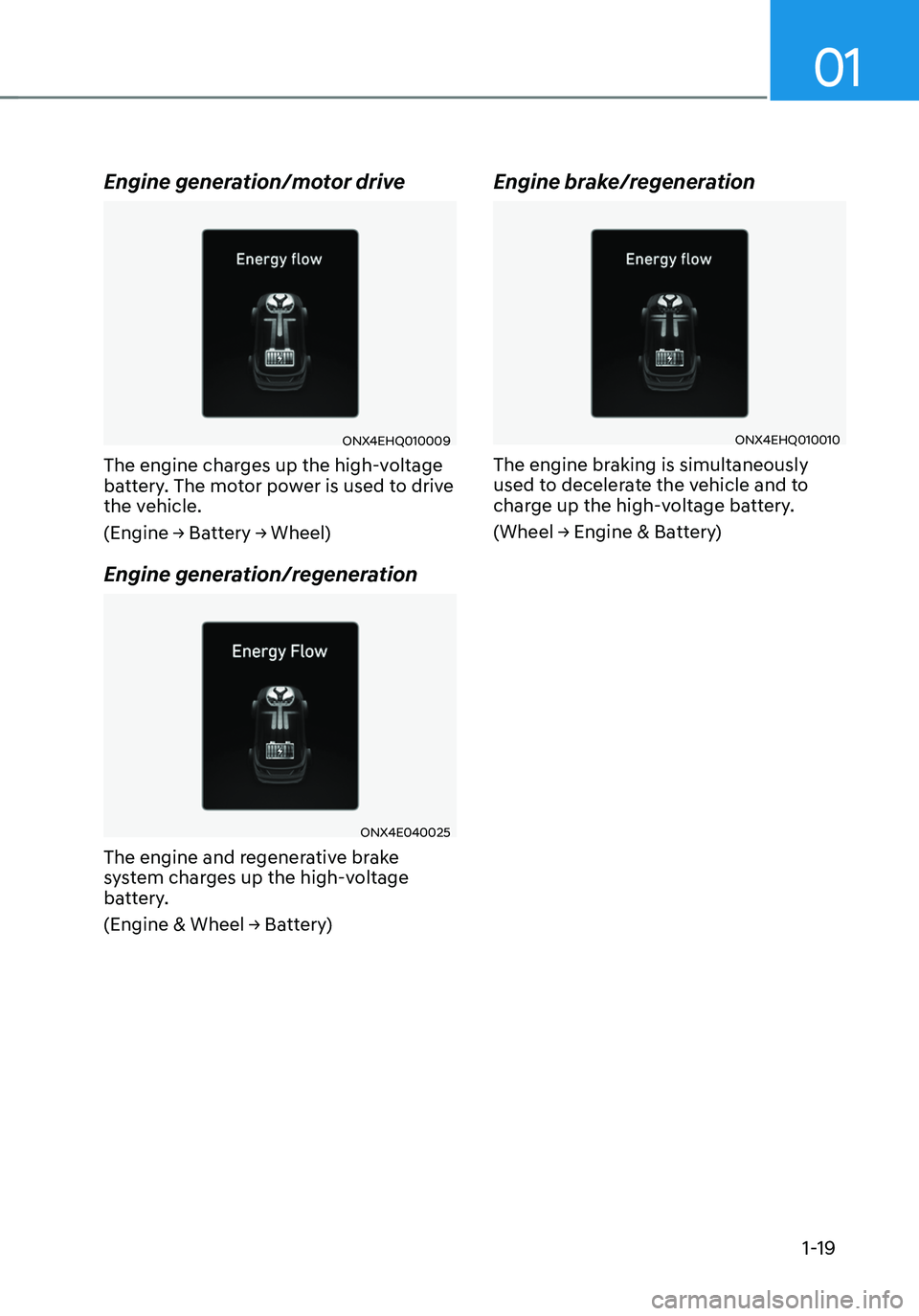
01
1-19
Engine generation/motor drive
ONX4EHQ010009
The engine charges up the high-voltage
battery. The motor power is used to drive
the vehicle.
(Engine → Battery → Wheel)
Engine generation/regeneration
ONX4E040025
The engine and regenerative brake
system charges up the high-voltage
battery.
(Engine & Wheel → Battery)
Engine brake/regeneration
ONX4EHQ010010
The engine braking is simultaneously
used to decelerate the vehicle and to
charge up the high-voltage battery.
(Wheel → Engine & Battery)
Page 24 of 630

Foreword / Hybrid System Overview
1-20
e-Handling (Electrically Assisted
Handling Performance)/e-EHA
(Electrically Evasive Handling
Assist)
e-Handling controls the electric motor
while turning around to improve the
handling performance, driving safety,
convenience and ride comfort.
e-EHA connects FCA (Forward Collision
Avoidance Assist) and the electric motor
to provide assists to avoid collision
so that prompt collision avoidance is
available while FCA warning appears.
Ãe-Handling stands for Electrically
Assisted Handling Performance.
Ãe-EHA means Electrically Evasive
Handling Assist.
Operation condition
e-Handling starts to work by identifying
enter or exit condition if the driver
operates the steering wheel over a
certain level when the vehicle speed is
between 40km/h and 120km/h.
e-EHA operates if there is urgent steering
wheel operation while FCA (Forward
Collision Avoidance Assist) warning
appears
Operation cancel
-When ESC operates
-When ABS works
CAUTION
The system does not work under the
following conditions.
-When the ESC operation stop light
is on
-When it does not work due to a
malfunction of electronic device
-When the manual transmission mode
is set
-The gear shift is not in D (Drive)
Information
Please refer to the chapter 6 “Paddle shift
(manual transmission mode) of automatic
transmission (electronic transmission
button)”
HYBRID DRIVING SYSTEM
Page 25 of 630
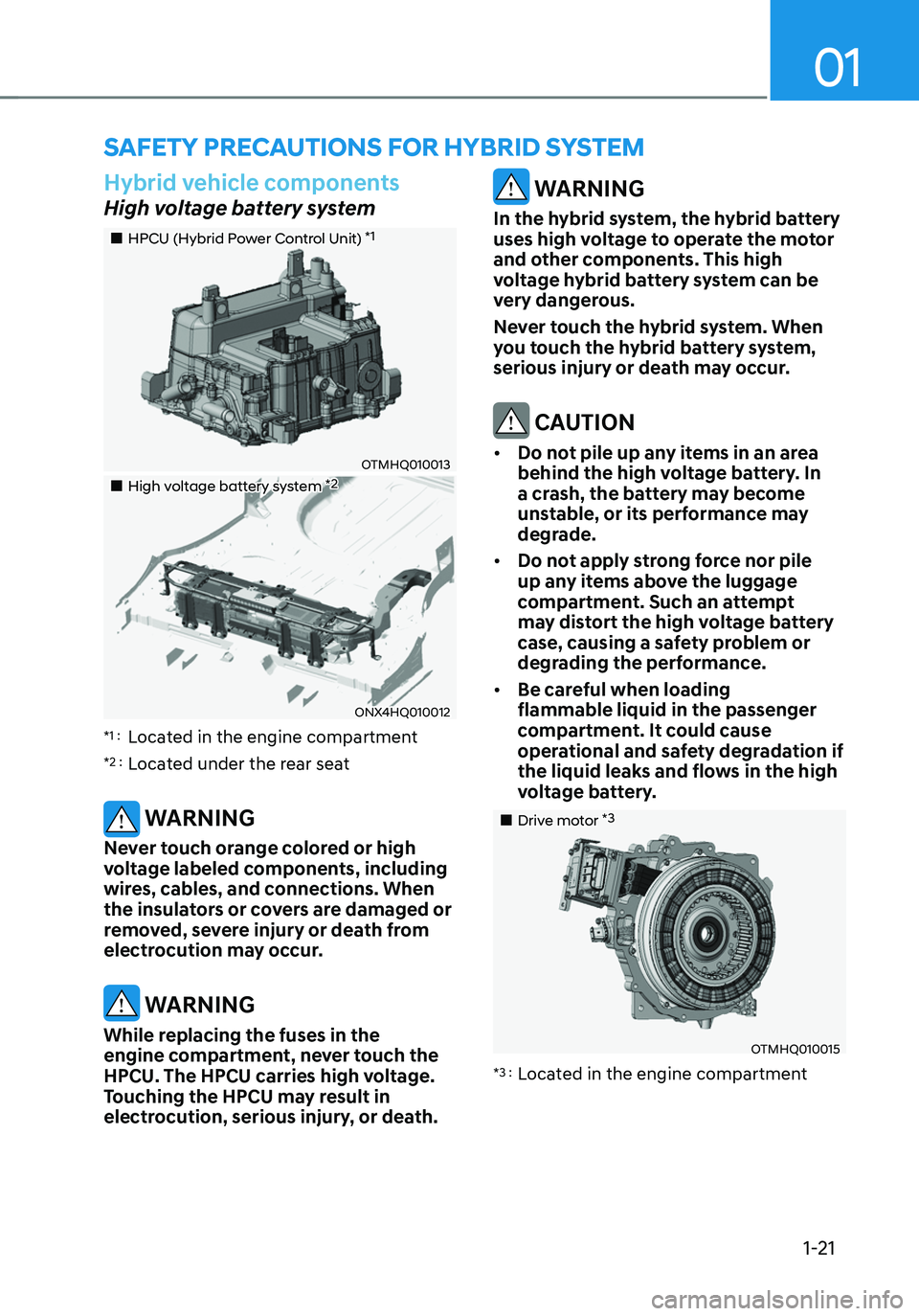
01
1-21
SAFETY PRECAUTIONS FOR HYBRID SYSTEM
Hybrid vehicle components
High voltage battery system
„„HPCU (Hybrid Power Control Unit) *1
OTMHQ010013
„„High voltage battery system *2
ONX4HQ010012
*1 : Located in the engine compartment
*2 : Located under the rear seat
WARNING
Never touch orange colored or high
voltage labeled components, including
wires, cables, and connections. When
the insulators or covers are damaged or
removed, severe injury or death from
electrocution may occur.
WARNING
While replacing the fuses in the
engine compartment, never touch the
HPCU. The HPCU carries high voltage.
Touching the HPCU may result in
electrocution, serious injury, or death.
WARNING
In the hybrid system, the hybrid battery
uses high voltage to operate the motor
and other components. This high
voltage hybrid battery system can be
very dangerous.
Never touch the hybrid system. When
you touch the hybrid battery system,
serious injury or death may occur.
CAUTION
• Do not pile up any items in an area
behind the high voltage battery. In
a crash, the battery may become
unstable, or its performance may
degrade.
• Do not apply strong force nor pile
up any items above the luggage
compartment. Such an attempt
may distort the high voltage battery
case, causing a safety problem or
degrading the performance.
• Be careful when loading
flammable liquid in the passenger
compartment. It could cause
operational and safety degradation if
the liquid leaks and flows in the high
voltage battery.
„„Drive motor *3
OTMHQ010015
*3 : Located in the engine compartment
Page 26 of 630
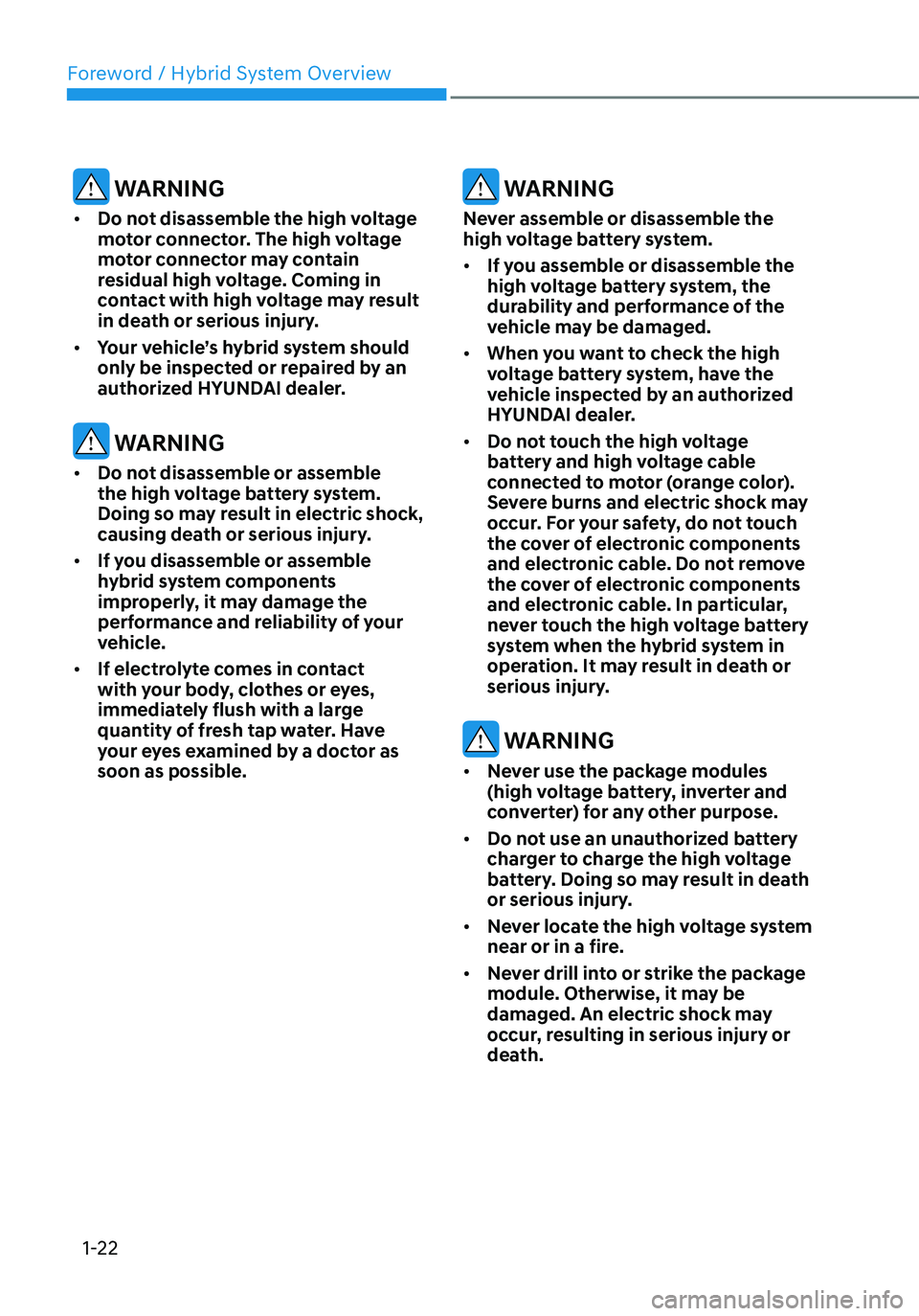
Foreword / Hybrid System Overview
1-22
WARNING
• Do not disassemble the high voltage
motor connector. The high voltage
motor connector may contain
residual high voltage. Coming in
contact with high voltage may result
in death or serious injury.
• Your vehicle’s hybrid system should
only be inspected or repaired by an
authorized HYUNDAI dealer.
WARNING
• Do not disassemble or assemble
the high voltage battery system.
Doing so may result in electric shock,
causing death or serious injury.
• If you disassemble or assemble
hybrid system components
improperly, it may damage the
performance and reliability of your
vehicle.
• If electrolyte comes in contact
with your body, clothes or eyes,
immediately flush with a large
quantity of fresh tap water. Have
your eyes examined by a doctor as
soon as possible.
WARNING
Never assemble or disassemble the
high voltage battery system.
• If you assemble or disassemble the
high voltage battery system, the
durability and performance of the
vehicle may be damaged.
• When you want to check the high
voltage battery system, have the
vehicle inspected by an authorized
HYUNDAI dealer.
• Do not touch the high voltage
battery and high voltage cable
connected to motor (orange color).
Severe burns and electric shock may
occur. For your safety, do not touch
the cover of electronic components
and electronic cable. Do not remove
the cover of electronic components
and electronic cable. In particular,
never touch the high voltage battery
system when the hybrid system in
operation. It may result in death or
serious injury.
WARNING
• Never use the package modules
(high voltage battery, inverter and
converter) for any other purpose.
• Do not use an unauthorized battery
charger to charge the high voltage
battery. Doing so may result in death
or serious injury.
• Never locate the high voltage system
near or in a fire.
• Never drill into or strike the package
module. Otherwise, it may be
damaged. An electric shock may
occur, resulting in serious injury or
death.
Page 27 of 630
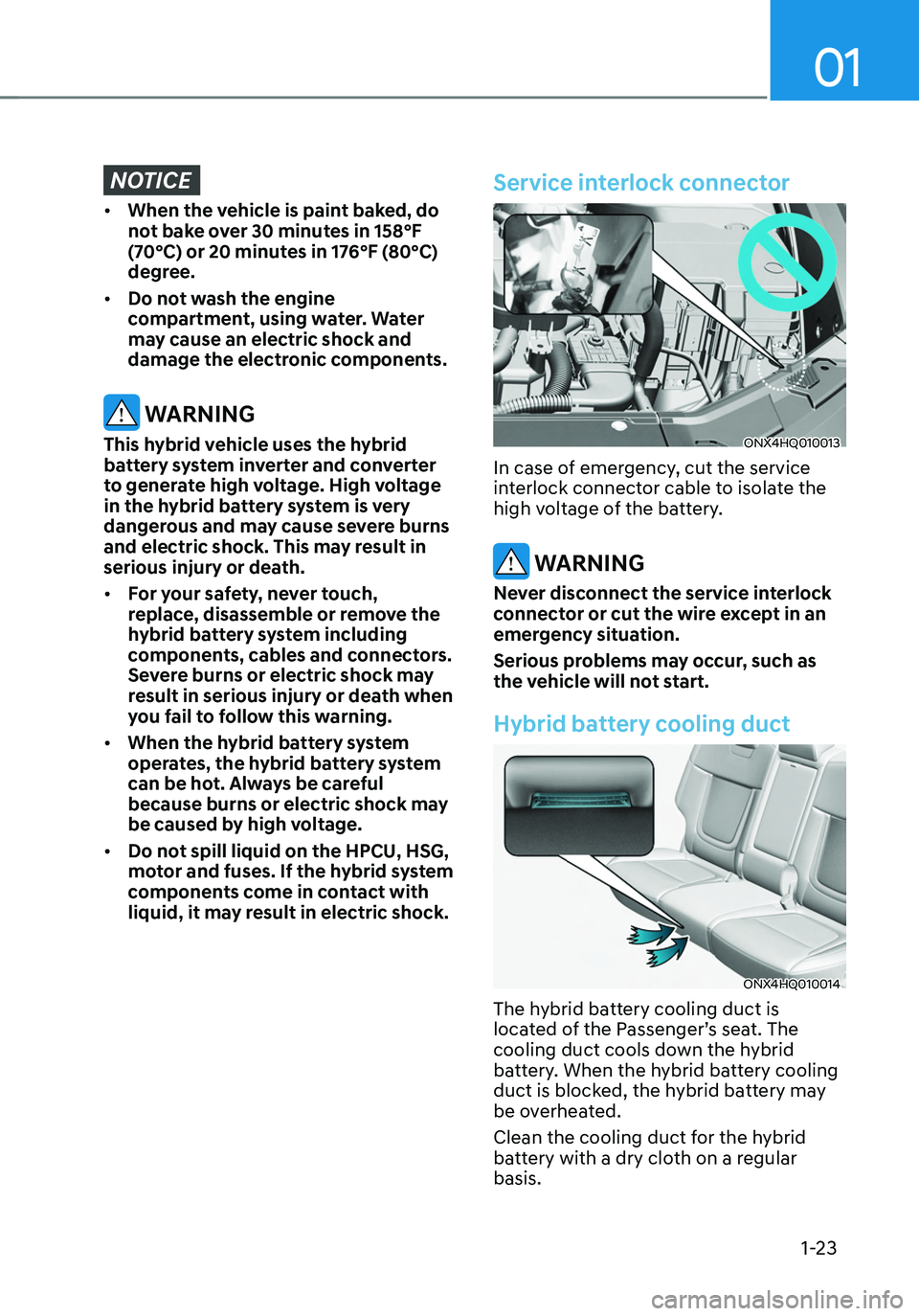
01
1-23
NOTICE
• When the vehicle is paint baked, do
not bake over 30 minutes in 158°F
(70°C) or 20 minutes in 176°F (80°C)
degree.
• Do not wash the engine
compartment, using water. Water
may cause an electric shock and
damage the electronic components.
WARNING
This hybrid vehicle uses the hybrid
battery system inverter and converter
to generate high voltage. High voltage
in the hybrid battery system is very
dangerous and may cause severe burns
and electric shock. This may result in
serious injury or death.
• For your safety, never touch,
replace, disassemble or remove the
hybrid battery system including
components, cables and connectors.
Severe burns or electric shock may
result in serious injury or death when
you fail to follow this warning.
• When the hybrid battery system
operates, the hybrid battery system
can be hot. Always be careful
because burns or electric shock may
be caused by high voltage.
• Do not spill liquid on the HPCU, HSG,
motor and fuses. If the hybrid system
components come in contact with
liquid, it may result in electric shock.
Service interlock connector
ONX4HQ010013
In case of emergency, cut the service
interlock connector cable to isolate the
high voltage of the battery.
WARNING
Never disconnect the service interlock
connector or cut the wire except in an
emergency situation.
Serious problems may occur, such as
the vehicle will not start.
Hybrid battery cooling duct
ONX4HQ010014
The hybrid battery cooling duct is
located of the Passenger’s seat. The
cooling duct cools down the hybrid
battery. When the hybrid battery cooling
duct is blocked, the hybrid battery may
be overheated.
Clean the cooling duct for the hybrid
battery with a dry cloth on a regular
basis.
Page 28 of 630
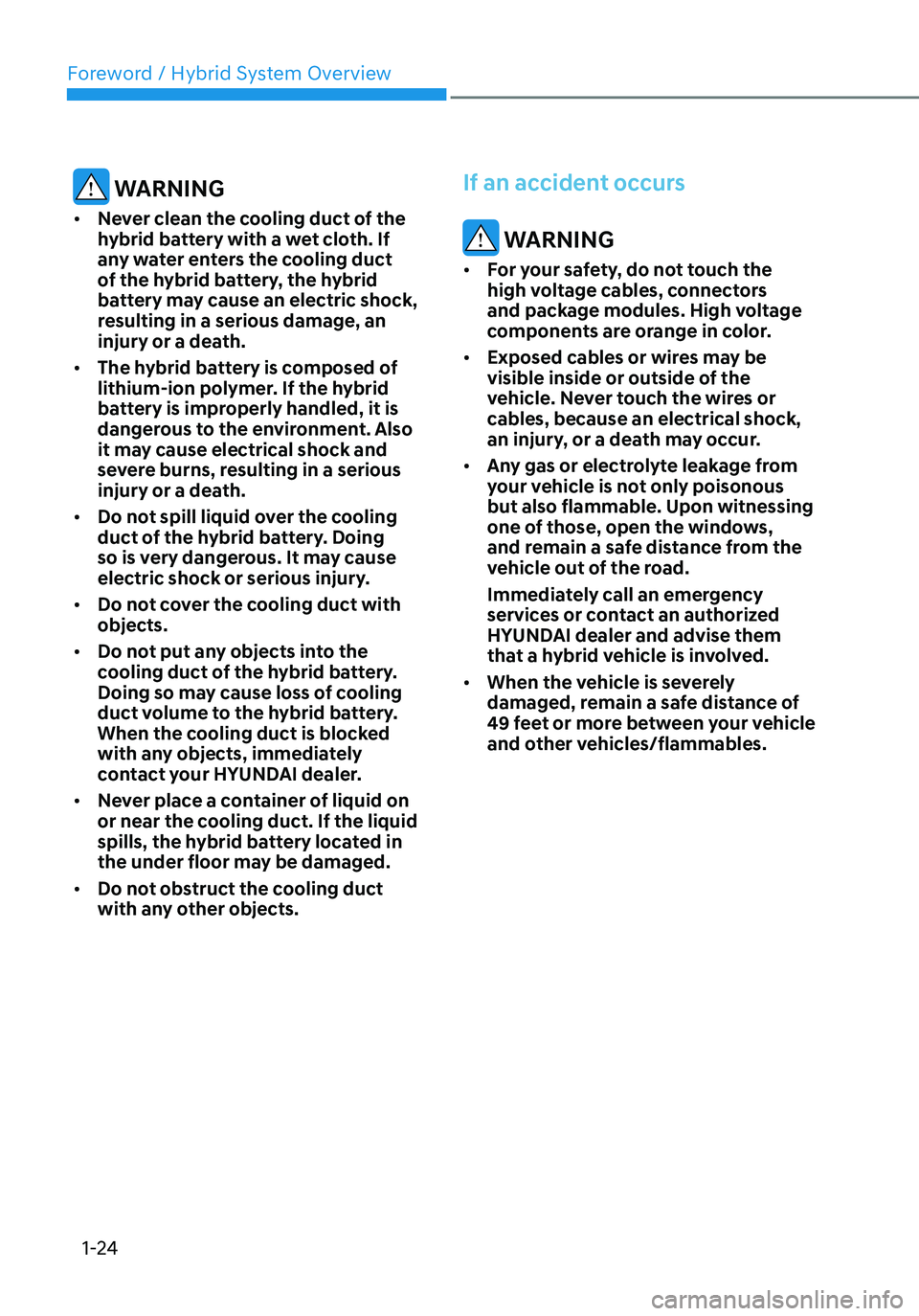
Foreword / Hybrid System Overview
1-24
WARNING
• Never clean the cooling duct of the
hybrid battery with a wet cloth. If
any water enters the cooling duct
of the hybrid battery, the hybrid
battery may cause an electric shock,
resulting in a serious damage, an
injury or a death.
• The hybrid battery is composed of
lithium-ion polymer. If the hybrid
battery is improperly handled, it is
dangerous to the environment. Also
it may cause electrical shock and
severe burns, resulting in a serious
injury or a death.
• Do not spill liquid over the cooling
duct of the hybrid battery. Doing
so is very dangerous. It may cause
electric shock or serious injury.
• Do not cover the cooling duct with
objects.
• Do not put any objects into the
cooling duct of the hybrid battery.
Doing so may cause loss of cooling
duct volume to the hybrid battery.
When the cooling duct is blocked
with any objects, immediately
contact your HYUNDAI dealer.
• Never place a container of liquid on
or near the cooling duct. If the liquid
spills, the hybrid battery located in
the under floor may be damaged.
• Do not obstruct the cooling duct
with any other objects.
If an accident occurs
WARNING
• For your safety, do not touch the
high voltage cables, connectors
and package modules. High voltage
components are orange in color.
• Exposed cables or wires may be
visible inside or outside of the
vehicle. Never touch the wires or
cables, because an electrical shock,
an injury, or a death may occur.
• Any gas or electrolyte leakage from
your vehicle is not only poisonous
but also flammable. Upon witnessing
one of those, open the windows,
and remain a safe distance from the
vehicle out of the road.
Immediately call an emergency
services or contact an authorized
HYUNDAI dealer and advise them
that a hybrid vehicle is involved.
• When the vehicle is severely
damaged, remain a safe distance of
49 feet or more between your vehicle
and other vehicles/flammables.
Page 29 of 630
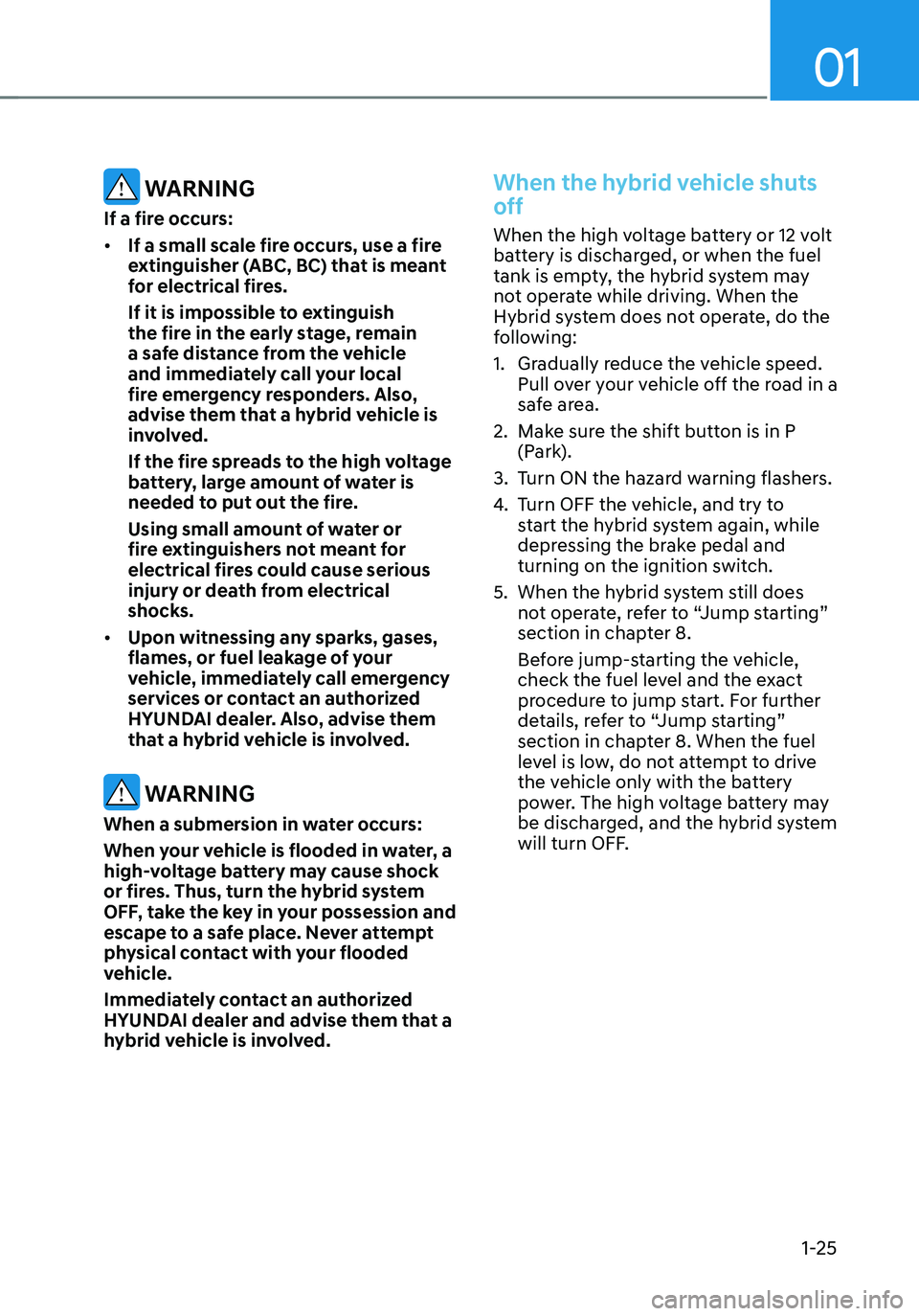
01
1-25
WARNING
If a fire occurs:
• If a small scale fire occurs, use a fire
extinguisher (ABC, BC) that is meant
for electrical fires.
If it is impossible to extinguish
the fire in the early stage, remain
a safe distance from the vehicle
and immediately call your local
fire emergency responders. Also,
advise them that a hybrid vehicle is
involved.
If the fire spreads to the high voltage
battery, large amount of water is
needed to put out the fire.
Using small amount of water or
fire extinguishers not meant for
electrical fires could cause serious
injury or death from electrical
shocks.
• Upon witnessing any sparks, gases,
flames, or fuel leakage of your
vehicle, immediately call emergency
services or contact an authorized
HYUNDAI dealer. Also, advise them
that a hybrid vehicle is involved.
WARNING
When a submersion in water occurs:
When your vehicle is flooded in water, a
high-voltage battery may cause shock
or fires. Thus, turn the hybrid system
OFF, take the key in your possession and
escape to a safe place. Never attempt
physical contact with your flooded
vehicle.
Immediately contact an authorized
HYUNDAI dealer and advise them that a
hybrid vehicle is involved.
When the hybrid vehicle shuts
off
When the high voltage battery or 12 volt
battery is discharged, or when the fuel
tank is empty, the hybrid system may
not operate while driving. When the
Hybrid system does not operate, do the
following:
1. Gradually reduce the vehicle speed.
Pull over your vehicle off the road in a
safe area.
2. Make sure the shift button is in P
(Park).
3. Turn ON the hazard warning flashers.
4. Turn OFF the vehicle, and try to
start the hybrid system again, while
depressing the brake pedal and
turning on the ignition switch.
5. When the hybrid system still does
not operate, refer to “Jump starting”
section in chapter 8.
Before jump-starting the vehicle,
check the fuel level and the exact
procedure to jump start. For further
details, refer to “Jump starting”
section in chapter 8. When the fuel
level is low, do not attempt to drive
the vehicle only with the battery
power. The high voltage battery may
be discharged, and the hybrid system
will turn OFF.
Page 30 of 630
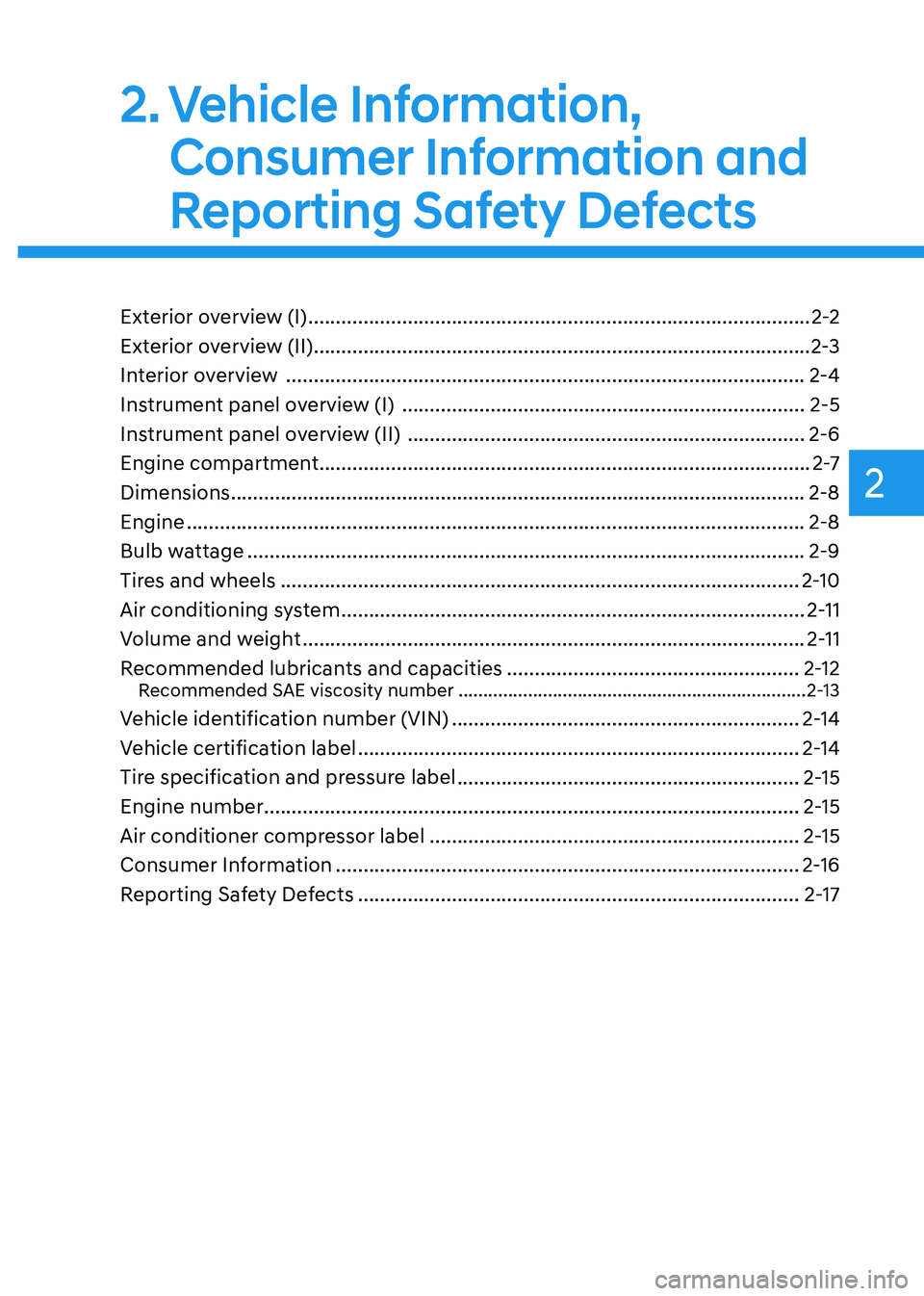
2. Vehicle Information,
Consumer Information and
Reporting Safety Defects
Vehicle Information, Consumer Information and Reporting Safety Defects
Exterior overview (I) ........................................................................\
...................2-2
Exterior overview (II)
........................................................................\
..................2-3
Interior overview
........................................................................\
......................2-4
Instrument panel overview (I)
........................................................................\
.2-5
Instrument panel overview (II)
........................................................................\
2-6
Engine compartment
........................................................................\
.................2-7
Dimensions
........................................................................\
................................2-8
Engine
........................................................................\
........................................2-8
Bulb wattage
........................................................................\
.............................2-9
Tires and wheels
........................................................................\
......................2-10
Air conditioning system
........................................................................\
............2-11
Volume and weight
........................................................................\
...................2-11
Recommended lubricants and capacities
.....................................................2-12Recommended SAE viscosity number ......................................................................2-13
Vehicle identification number (VIN) ...............................................................2-14
Vehicle certification label
........................................................................\
........2-14
Tire specification and pressure label
..............................................................2-15
Engine number
........................................................................\
.........................2-15
Air conditioner compressor label
...................................................................2-15
Consumer Information
........................................................................\
............2-16
Reporting Safety Defects
........................................................................\
........2-17
2